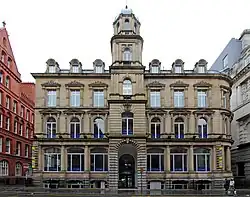| The Temple | |
|---|---|
 | |
| Location | 22A and 24 Dale Street, Liverpool, Merseyside, England |
| Coordinates | 53°24′28″N 2°59′20″W / 53.4077°N 2.9890°W |
| OS grid reference | SJ 344 906 |
| Built | 1864–65 |
| Built for | Sir William Brown |
| Architect | Sir James Picton |
Listed Building – Grade II | |
| Designated | 14 March 1975 |
| Reference no. | 1206475 |
 Location in Liverpool | |
The Temple is an office building at 22A and 24 Dale Street, Liverpool, Merseyside, England.
History
The Temple was constructed in 1864–65.[1] It was built for the banker Sir William Brown and designed by Sir James Picton.[2] Leading from the rear of the building were two brick ranges with large windows. The west range has been converted into flats; the east range has been demolished, and was replaced in 2001 by a new building.[3]
Architecture
The building is in stone, with a grey granite basement and a lead roof. It has three storeys plus a basement and an attic. The entrance front on Dale Street has seven bays and a curved bay leading round into Princess Street on the left corner. The surround to the round-arched entrance is rusticated.[1] Over the entrance is a carving of four hands, clasped together, and the words "Harmony Becomes Brothers".[2] Also in the ground floor is a Tuscan colonnade, a panelled frieze and a cornice. The first floor is rusticated, and above the entrance is a segmental-headed window surmounted by arms. Above this on the second floor is a round-headed window with flat Ionic pilasters. Rising over this is a two-stage tower with a lead cupola and finials. The building has a Mansard roof. It is recorded in the National Heritage List for England as a designated Grade II listed building.[1]
See also
References
- 1 2 3 Historic England, "The Temple, Liverpool (1206475)", National Heritage List for England, retrieved 22 August 2011
- 1 2 Pye, Ken (2011), Discover Liverpool, Liverpool: Trinity Mirror Media, p. 84, ISBN 978-1-906802-90-5
- ↑ Pollard, Richard; Pevsner, Nikolaus (2006), Lancashire: Liverpool and the South-West, The Buildings of England, New Haven and London: Yale University Press, p. 319, ISBN 0-300-10910-5



